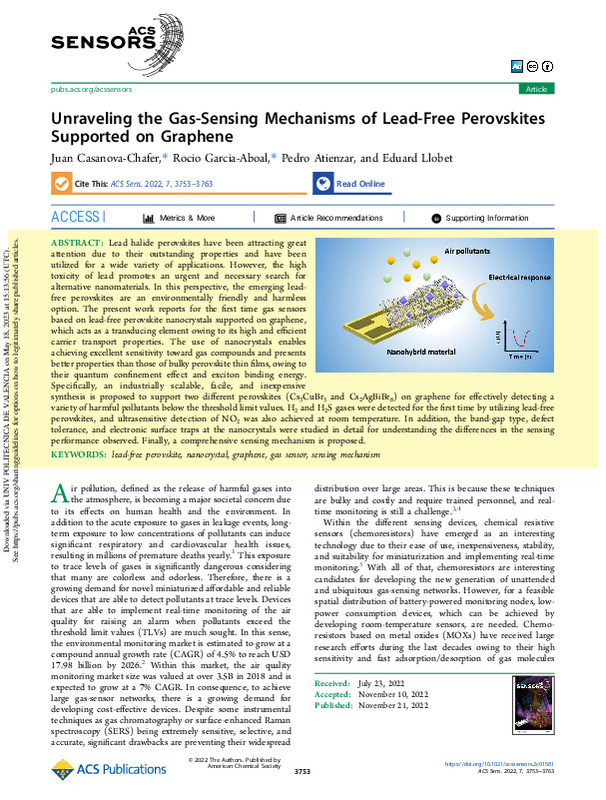JavaScript is disabled for your browser. Some features of this site may not work without it.
Buscar en RiuNet
Listar
Mi cuenta
Estadísticas
Ayuda RiuNet
Admin. UPV
Unraveling the Gas-Sensing Mechanisms of Lead-Free Perovskites Supported on Graphene
Mostrar el registro sencillo del ítem
Ficheros en el ítem
| dc.contributor.author | Casanova-Chafer, Juan
|
es_ES |
| dc.contributor.author | García-Aboal, Rocío
|
es_ES |
| dc.contributor.author | Atienzar Corvillo, Pedro Enrique
|
es_ES |
| dc.contributor.author | Llobet, Eduard
|
es_ES |
| dc.date.accessioned | 2023-05-23T18:01:52Z | |
| dc.date.available | 2023-05-23T18:01:52Z | |
| dc.date.issued | 2022-12-23 | es_ES |
| dc.identifier.uri | http://hdl.handle.net/10251/193538 | |
| dc.description.abstract | [EN] Lead halide perovskites have been attracting great attention due to their outstanding properties and have been utilized for a wide variety of applications. However, the high toxicity of lead promotes an urgent and necessary search for alternative nanomaterials. In this perspective, the emerging leadfree perovskites are an environmentally friendly and harmless option. The present work reports for the first time gas sensors based on lead-free perovskite nanocrystals supported on graphene, which acts as a transducing element owing to its high and efficient carrier transport properties. The use of nanocrystals enables achieving excellent sensitivity toward gas compounds and presents better properties than those of bulky perovskite thin films, owing to their quantum confinement effect and exciton binding energy. Specifically, an industrially scalable, facile, and inexpensive synthesis is proposed to support two different perovskites (Cs3CuBr5 and Cs2AgBiBr6) on graphene for effectively detecting a variety of harmful pollutants below the threshold limit values. H2 and H2S gases were detected for the first time by utilizing lead-free perovskites, and ultrasensitive detection of NO2 was also achieved at room temperature. In addition, the band-gap type, defect tolerance, and electronic surface traps at the nanocrystals were studied in detail for understanding the differences in the sensing performance observed. Finally, a comprehensive sensing mechanism is proposed. | es_ES |
| dc.description.sponsorship | This study was funded in part by the Marie Sklodowska-Curie Actions (MSCA) Research and Innovation Staff Exchange (RISE), no. H2020-MSCA-RISE-2018-823895 "SENSOFT", by MICINN and FEDER grant no. RTI2018-101580-I00 and AGAUR grant no. 2017 SGR 418. J.C.-C. is supported by a postdoctoral ICREA grant. P.A . acknowledges the financial support from the Spanish Government through no. PGC2018-099744-B-I00 (MCIU/AEI/FEDER) and Generalitat Valenciana (no. AICO/2020/149). E.L. is supported by the Catalan Institute for advanced studies (ICREA) via the 2018 Edition of the ICREA Academia Award. The authors also thank the Electron Microscopy Service of the Universitat Polite`cnica de Valencia for their support in HRTEM and FESEM image acquisition. | es_ES |
| dc.language | Inglés | es_ES |
| dc.publisher | American Chemical Society | es_ES |
| dc.relation.ispartof | ACS Sensors | es_ES |
| dc.rights | Reconocimiento (by) | es_ES |
| dc.subject | Lead-free perovskite | es_ES |
| dc.subject | Nanocrystal | es_ES |
| dc.subject | Graphene | es_ES |
| dc.subject | Gas sensor | es_ES |
| dc.subject | Sensing mechanism | es_ES |
| dc.title | Unraveling the Gas-Sensing Mechanisms of Lead-Free Perovskites Supported on Graphene | es_ES |
| dc.type | Artículo | es_ES |
| dc.identifier.doi | 10.1021/acssensors.2c01581 | es_ES |
| dc.relation.projectID | info:eu-repo/grantAgreement/AEI/Plan Estatal de Investigación Científica y Técnica y de Innovación 2017-2020/PGC2018-099744-B-I00/ES/AMPLIFICACION DE LOS FENOMENOS OPTOELECTRONICOS EN MICROCAVIDADES/ | es_ES |
| dc.relation.projectID | info:eu-repo/grantAgreement/AGAUR//2017SGR 418/ | es_ES |
| dc.relation.projectID | info:eu-repo/grantAgreement/AEI/Plan Estatal de Investigación Científica y Técnica y de Innovación 2017-2020/RTI2018-101580-B-I00/ES/SENSADO DE GASES DISTRIBUIDO Y AUTONOMO EMPLEANDO NANOMATERIALES DE BAJA DIMENSION/ | es_ES |
| dc.relation.projectID | info:eu-repo/grantAgreement/GVA//AICO%2F2020%2F149/ | es_ES |
| dc.relation.projectID | info:eu-repo/grantAgreement/EC/H2020/823895/EU | es_ES |
| dc.rights.accessRights | Abierto | es_ES |
| dc.description.bibliographicCitation | Casanova-Chafer, J.; García-Aboal, R.; Atienzar Corvillo, PE.; Llobet, E. (2022). Unraveling the Gas-Sensing Mechanisms of Lead-Free Perovskites Supported on Graphene. ACS Sensors. 7(12):3753-3763. https://doi.org/10.1021/acssensors.2c01581 | es_ES |
| dc.description.accrualMethod | S | es_ES |
| dc.relation.publisherversion | https://doi.org/10.1021/acssensors.2c01581 | es_ES |
| dc.description.upvformatpinicio | 3753 | es_ES |
| dc.description.upvformatpfin | 3763 | es_ES |
| dc.type.version | info:eu-repo/semantics/publishedVersion | es_ES |
| dc.description.volume | 7 | es_ES |
| dc.description.issue | 12 | es_ES |
| dc.identifier.eissn | 2379-3694 | es_ES |
| dc.identifier.pmid | 36410796 | es_ES |
| dc.identifier.pmcid | PMC9791682 | es_ES |
| dc.relation.pasarela | S\493277 | es_ES |
| dc.contributor.funder | European Commission | es_ES |
| dc.contributor.funder | Generalitat Valenciana | es_ES |
| dc.contributor.funder | Agencia Estatal de Investigación | es_ES |
| dc.contributor.funder | European Regional Development Fund | es_ES |
| dc.contributor.funder | Ministerio de Ciencia e Innovación | es_ES |
| dc.contributor.funder | Institució Catalana de Recerca i Estudis Avançats | es_ES |
| dc.contributor.funder | Agencia de Gestión de Ayudas Universitarias y de Investigación | es_ES |








